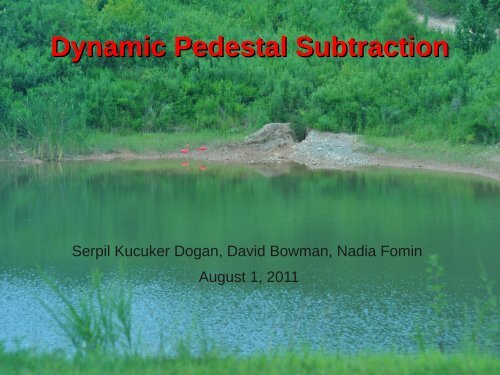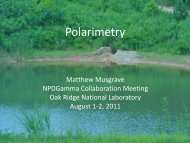Dynamic Pedestal Subtraction
Dynamic Pedestal Subtraction
Dynamic Pedestal Subtraction
- No tags were found...
You also want an ePaper? Increase the reach of your titles
YUMPU automatically turns print PDFs into web optimized ePapers that Google loves.
Outline●●●●●How to determine pedestals dynamically.What contributes to the <strong>Pedestal</strong>?Why do we call it “<strong>Dynamic</strong>”?What is the Algorithm?Conclusion
LANSCE vs. SNSLANSCE SignalSNS Signal
What contributes to the <strong>Pedestal</strong>?● Electronic <strong>Pedestal</strong> → “P e”● P edata taken when the shutter is closed
What else?●●β delayed γ's27Al+n → 28Al*+γThe data is taken by shutterclosing during the run.
Why do we call it “<strong>Dynamic</strong>”?●●The β-delayed γ's depend on the irradiation ofthe target. They can change because of theradiation history.The Electronic <strong>Pedestal</strong> may drift because ofthe radiation history.
How do we get “g” factor?●●●●“g” does not depend on the irradiation history.“g” is a constant, independent of energy andintensity.“g” is a diagnostic.Get it from a missed(dropped) pulse.
Calculations●Step 1: Look at the pedestal run with shutter closed in order tofind out the averaged electrical pedestal.P e=0.00477V
●Step 2: Find the missing pulse in order to calculate the “g” foreach detector.
●Step 3: Apply fits to the missing pulse and one of the macropulses that comes before the missing pulse in order to determinePed., V 1and V 2.Ped=0.407VV 1=1.486VV 2=2.732V
Detector vs. 'g' factor for Al target
Detector vs. 'g' factor for Cl target
Calculating the <strong>Dynamic</strong> <strong>Pedestal</strong>s●Using the 'g' factors, the dynamic pedestalswere calculated.Ped=V 1.(1+g)-V 2.g●●The Asymmetry Branch was updated, insertingthe dynamic pedestals.Increase in the Asymmetry after the subtraction.
Very Preliminary Results for Al
Very Preliminary Results for Cl
●We also calculated theratio of the pedestal to theaveraged signal of apulse:Ped/V ave.=0.186●It is in completeagreement with thetheoretical calculation.(Delayed Al γ’s) / (PromptAl γ’s+ Delayed Al γ’s)=1.78/(1.78+7.85)=0.185
●Step 1: Analyze the data file when the shutterwas closed partway through.
●●Step 2: Make a fit andfind out the Al decaytime from our data.The decay tail timeconstant is consistentwith 28 Al.● τ fit= 196 sec ± 10 secτ Led et al=198.2 sec±4secEXT PARAMETERNAME VALUE ERRORp0 8.875e-01 2.176e-04p1 1.957e+02 4.959e-02p2 9.168e-02 2.949e-05
Conclusion●●●●Demonstrate the “g” algorithm“g” diagnostics<strong>Pedestal</strong> subtractionIncreases the Asymmetry






